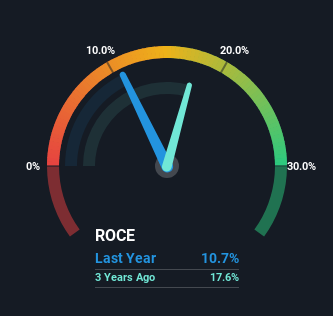- Hong Kong
- /
- Consumer Durables
- /
- SEHK:1568
The Returns On Capital At Sundart Holdings (HKG:1568) Don't Inspire Confidence
What trends should we look for it we want to identify stocks that can multiply in value over the long term? Ideally, a business will show two trends; firstly a growing return on capital employed (ROCE) and secondly, an increasing amount of capital employed. Basically this means that a company has profitable initiatives that it can continue to reinvest in, which is a trait of a compounding machine. However, after briefly looking over the numbers, we don't think Sundart Holdings (HKG:1568) has the makings of a multi-bagger going forward, but let's have a look at why that may be.
Return On Capital Employed (ROCE): What Is It?
Just to clarify if you're unsure, ROCE is a metric for evaluating how much pre-tax income (in percentage terms) a company earns on the capital invested in its business. To calculate this metric for Sundart Holdings, this is the formula:
Return on Capital Employed = Earnings Before Interest and Tax (EBIT) ÷ (Total Assets - Current Liabilities)
0.11 = HK$369m ÷ (HK$7.2b - HK$3.8b) (Based on the trailing twelve months to December 2023).
Thus, Sundart Holdings has an ROCE of 11%. That's a relatively normal return on capital, and it's around the 12% generated by the Consumer Durables industry.
Check out our latest analysis for Sundart Holdings

Historical performance is a great place to start when researching a stock so above you can see the gauge for Sundart Holdings' ROCE against it's prior returns. If you want to delve into the historical earnings , check out these free graphs detailing revenue and cash flow performance of Sundart Holdings.
What The Trend Of ROCE Can Tell Us
On the surface, the trend of ROCE at Sundart Holdings doesn't inspire confidence. Around five years ago the returns on capital were 19%, but since then they've fallen to 11%. However, given capital employed and revenue have both increased it appears that the business is currently pursuing growth, at the consequence of short term returns. And if the increased capital generates additional returns, the business, and thus shareholders, will benefit in the long run.
Another thing to note, Sundart Holdings has a high ratio of current liabilities to total assets of 52%. This can bring about some risks because the company is basically operating with a rather large reliance on its suppliers or other sorts of short-term creditors. Ideally we'd like to see this reduce as that would mean fewer obligations bearing risks.
The Key Takeaway
While returns have fallen for Sundart Holdings in recent times, we're encouraged to see that sales are growing and that the business is reinvesting in its operations. But since the stock has dived 88% in the last five years, there could be other drivers that are influencing the business' outlook. Regardless, reinvestment can pay off in the long run, so we think astute investors may want to look further into this stock.
Sundart Holdings does come with some risks though, we found 3 warning signs in our investment analysis, and 1 of those doesn't sit too well with us...
While Sundart Holdings isn't earning the highest return, check out this free list of companies that are earning high returns on equity with solid balance sheets.
New: Manage All Your Stock Portfolios in One Place
We've created the ultimate portfolio companion for stock investors, and it's free.
• Connect an unlimited number of Portfolios and see your total in one currency
• Be alerted to new Warning Signs or Risks via email or mobile
• Track the Fair Value of your stocks
Have feedback on this article? Concerned about the content? Get in touch with us directly. Alternatively, email editorial-team (at) simplywallst.com.
This article by Simply Wall St is general in nature. We provide commentary based on historical data and analyst forecasts only using an unbiased methodology and our articles are not intended to be financial advice. It does not constitute a recommendation to buy or sell any stock, and does not take account of your objectives, or your financial situation. We aim to bring you long-term focused analysis driven by fundamental data. Note that our analysis may not factor in the latest price-sensitive company announcements or qualitative material. Simply Wall St has no position in any stocks mentioned.
About SEHK:1568
Sundart Holdings
An investment holding company, operates as a fitting out contractor in Hong Kong, Macau, Singapore, and the People’s Republic of China.
Flawless balance sheet, good value and pays a dividend.
Market Insights
Community Narratives




